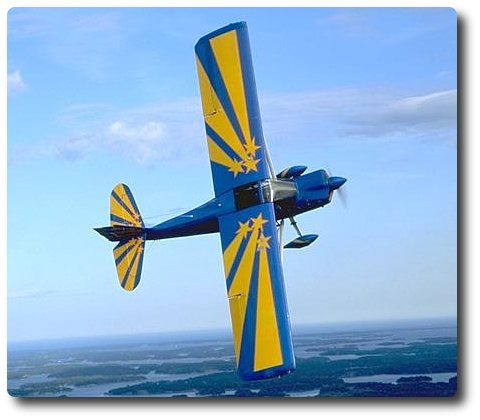Ethanol has been available for nearly a century. But we are now finding ways to use it for more things and to help us on our reliance on foreign oil. Baylor University has done numerous tests on ethanol in acrobatic general aviation aircraft as well as passenger high and low performance aircraft.
The Bellanca Decathlon a symmetrical winged Citabria for aerobatics was tested with 100% hydrous ethanol, which was gotten from an M & M Mars Candy Manufacturing plant. Ethanol was thought to be dangerous when it was 10-15% mixed with water due to the condensation aspects of water in aircraft engines another good reason for preflight inspections.
It was found that with a 100% hydrous ethanol there was no de crease in performance and to the contrary a slight increase in less knocking under demand for power. When put into a Pitts Special S1S where the compression ratios were 10:1 the ethanol had a higher performance when temperatures were over 100 degrees. The 50/50 blended fuel had a decrease slightly of up to 15-20%. But did comparable under hotter temperatures of air intake or ambient air. Eleven aircraft were tested at Baylor University the larger the engines the better the ethanol did.
crease in performance and to the contrary a slight increase in less knocking under demand for power. When put into a Pitts Special S1S where the compression ratios were 10:1 the ethanol had a higher performance when temperatures were over 100 degrees. The 50/50 blended fuel had a decrease slightly of up to 15-20%. But did comparable under hotter temperatures of air intake or ambient air. Eleven aircraft were tested at Baylor University the larger the engines the better the ethanol did.
Ethanol also increased the TBO, total time to recommended or predicted overhaul by 50% meaning less wear on the engine, probably due to less knock. The FAA certified the IO-540 a very popular general aviation engine in March of 1990. So much of this is nothing new. The FAA even stating that it exceeded the tests. Aviation fuel is the last fuel available with lead in it. This has taken some 22 years to develop and now it appears aircraft with piston engines can use ethanol and perform better in many instances. This is especially good for those states, which grow corn such as Nebraska, ND, SD, Iowa and others.
The push for this type of fuel is coming predominantly from the areas in the US where corn grows which elevates the price of corn for farmers. Corn, a commodity can also be used to eat obviously and of course like oil can be used to make plastics and other important materials for a myriad of uses. Next time you think of corn, think of more than just food. The Navajo Indians made it into food by pounding the crap out of it, they were on to something there. Corn is a big deal to many states where it can be grown in abundance.
It appears that if ethanol provides better performance in hotter climates then perhaps we may wish to sell ethanol for aircraft in those markets unless the pilots will fly much above 12,000 feet where the air is cooler. The average of 2 degrees per thousand feet decrease in ambient temperature, flying over mountains could be an issue. But these are most interesting facts for military vehicles in the middle east, cars in hot climates and of course for aviation also.
If you have any ideas on alternative fuel for aircraft please let's explore and discuss these issues.
"Lance Winslow" - Online Think Tank forum board. If you have innovative thoughts and unique perspectives, come think with Lance; www.WorldThinkTank.net/wttbbs/
Article Source: http://EzineArticles.com/?expert=Lance_Winslow
